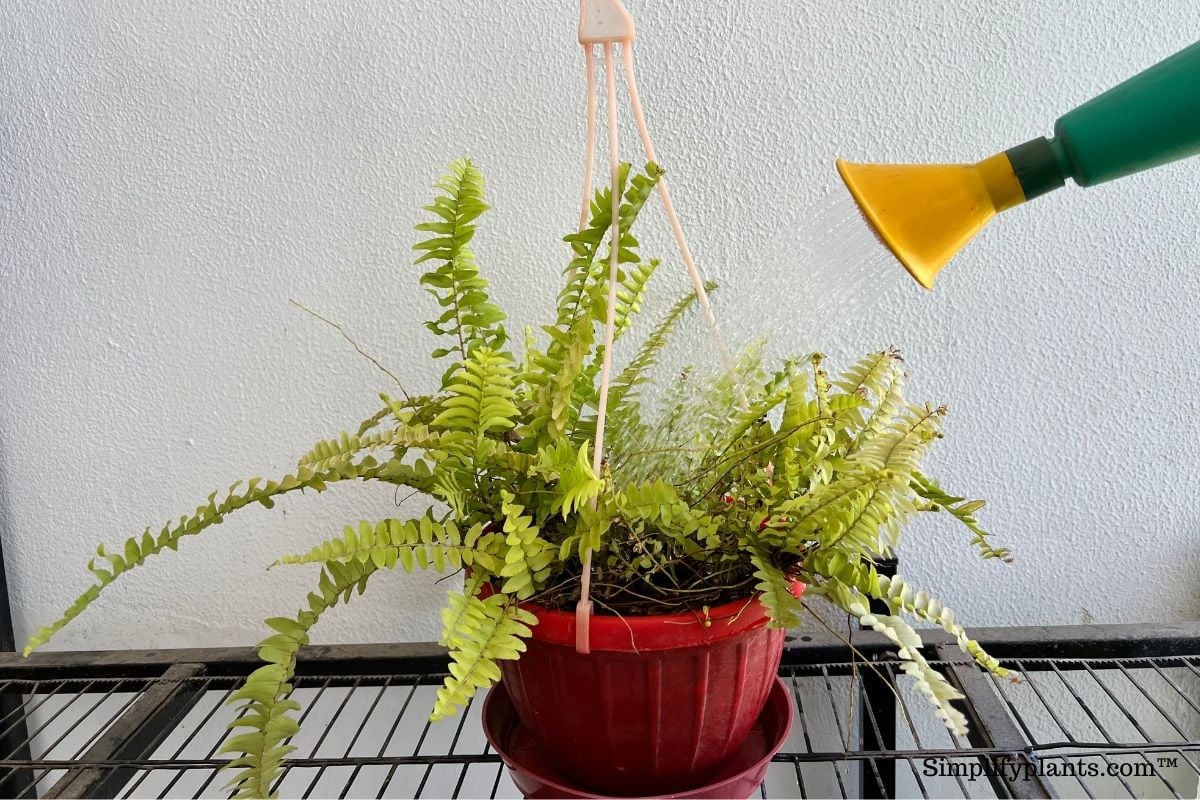Introduction to Fern Watering

Ferns, with their delicate fronds and lush appearance, are popular houseplants. However, their specific watering needs are often misunderstood. Proper watering is crucial for maintaining their vibrant health and preventing potential issues like wilting or rot. Understanding the nuances of fern watering is essential for ensuring their long-term well-being.
Watering ferns effectively requires a balance between providing sufficient moisture and avoiding overwatering, a common pitfall for fern owners. This delicate balance is achieved by considering factors like the type of fern, the soil’s moisture content, and the environmental conditions. By recognizing these factors, you can create a watering schedule that promotes healthy growth and longevity.
Fern Types and Watering
Different fern varieties exhibit varying water needs. Some ferns, like the Boston fern, prefer consistently moist soil, while others, like the Staghorn fern, tolerate drier conditions. Understanding the specific needs of your fern variety is vital for establishing an appropriate watering routine. This knowledge will prevent issues arising from inappropriate watering frequencies.
Soil Moisture and Watering Frequency
The moisture content of the soil plays a critical role in determining the ideal watering frequency for your fern. The soil should always be moist but never waterlogged. Overwatering can lead to root rot, a devastating condition that often results in the plant’s demise. Underwatering, while less immediately destructive, can lead to wilting and a loss of vigor. Regularly checking the soil moisture is crucial for establishing a suitable watering schedule.
Determining Soil Moisture
To determine the right watering frequency, you should regularly check the soil moisture. Insert a fingertip about an inch into the soil. If the top inch of soil feels dry, it’s time to water. If the soil feels consistently moist, you may want to adjust your watering schedule. Monitoring the soil’s moisture levels is a simple yet effective way to ensure optimal fern hydration.
Watering Techniques
Watering ferns should be done thoroughly, ensuring that the water reaches the roots and the soil is evenly moistened. Avoid letting water accumulate in the fern’s crown or fronds, as this can lead to fungal issues. Using a watering can with a gentle stream is often preferred over a forceful spray. This approach prevents the dislodgement of the fern’s delicate foliage.
Factors Influencing Watering Frequency

Understanding the nuances of fern watering goes beyond a simple schedule. Various factors play a crucial role in determining how often your fern needs hydration. These factors, ranging from the plant’s inherent characteristics to environmental conditions, are key to maintaining its health and vibrancy.
Impact of Fern Size and Type
Fern species and their sizes significantly impact their water requirements. Larger ferns, with extensive root systems and leaf canopies, generally need more frequent watering than smaller varieties. The type of fern also matters; some ferns are naturally more drought-tolerant than others. For example, Boston ferns, with their relatively delicate foliage, tend to require more frequent watering than the hardy sword fern. This variation in water needs is a crucial factor in developing an appropriate watering strategy.
Influence of Pot Size and Material
The size and material of the pot greatly affect water retention. Smaller pots, due to their limited capacity, dry out faster than larger ones. Furthermore, the pot’s material plays a significant role. Terracotta pots, for instance, are porous, allowing water to evaporate more quickly than plastic pots. This faster evaporation rate necessitates more frequent watering for ferns in terracotta containers. Consider using a moisture meter to determine the precise level of soil moisture in the pot.
Effect of Environmental Conditions, How often to water ferns
Environmental conditions, including humidity and temperature, directly influence a fern’s water needs. High humidity environments reduce the need for frequent watering, as the air provides a moisture source. Conversely, dry air necessitates more frequent watering to compensate for the loss of moisture. Similarly, higher temperatures accelerate evaporation, requiring more frequent watering to maintain optimal moisture levels in the soil. Observe your fern’s response to these environmental shifts to fine-tune your watering schedule.
Comparison of Potting Mixes
Different potting mixes have varying water-holding capacities. A mix rich in peat moss or other organic matter retains moisture longer, thus reducing the frequency of watering. Conversely, mixes with a higher proportion of perlite or sand tend to dry out more quickly, necessitating more frequent watering. Consider the water-holding capacity of your chosen potting mix when establishing your fern’s watering schedule.
Significance of Light Exposure
Light exposure also significantly impacts the fern’s water needs. Ferns thriving in low-light conditions generally require less frequent watering, as they have lower transpiration rates. In contrast, ferns placed in brighter, sunnier areas experience higher transpiration rates, necessitating more frequent watering to compensate for the increased moisture loss. Assess the light conditions surrounding your fern to adjust your watering frequency accordingly.
Methods for Determining Watering Needs

Proper watering is crucial for fern health, as overwatering and underwatering can both lead to problems. Knowing how much water your fern needs involves understanding the moisture content of the soil. This crucial step allows you to provide the right amount of hydration, preventing stress and promoting robust growth.
Assessing soil moisture is the cornerstone of effective fern watering. Regular checks ensure your fern receives the precise amount of water it requires, preventing both drought stress and root rot. Consistent monitoring helps you fine-tune your watering schedule, making it more efficient and less prone to error.
Checking Soil Moisture
Understanding the moisture level of the soil is paramount for determining the appropriate watering frequency. This crucial step allows you to provide the right amount of hydration, preventing stress and promoting robust growth. Different methods can be used to assess soil moisture.
- Using Your Finger: A simple and readily available method involves inserting your finger about an inch into the soil. Feel the moisture level; if the soil feels dry to the touch, the fern needs water. If it feels moist, hold off on watering for a bit. A good guideline is to water when the top inch or two of soil feels dry. This method provides a quick, practical way to gauge soil moisture, making it suitable for daily or frequent checks. The soil’s texture and composition can influence how dry it feels, so use this method in conjunction with other techniques.
- Utilizing a Moisture Meter: Moisture meters are electronic devices that measure the soil’s moisture content. They provide a more objective assessment compared to using your finger. Moisture meters usually have a scale to indicate the moisture level, with readings typically ranging from “dry” to “saturated.” These devices are particularly useful for beginners or those who want a more precise method. A benefit is their ability to detect subtle changes in moisture levels, which can be helpful in preventing overwatering.
Comparing Methods
A table comparing the methods helps illustrate their strengths and weaknesses.
| Method | Pros | Cons |
|---|---|---|
| Finger | Simple, readily available, inexpensive | Subjective, can be influenced by soil type |
| Moisture Meter | Objective, precise, less subjective | Requires an investment, can be inaccurate if not calibrated correctly |
Developing a Watering Schedule
Establishing a consistent watering schedule is key to fern health. A step-by-step guide will help in determining the appropriate watering frequency.
- Initial Assessment: Begin by checking the soil moisture using either your finger or a moisture meter. This initial assessment will provide a baseline for future checks.
- Regular Monitoring: Monitor the soil moisture regularly. Observe how quickly the soil dries out, taking into account the specific fern variety and environmental conditions. This step is essential to adjusting the watering schedule over time.
- Adjusting Frequency: Based on your observations, adjust the watering frequency. If the soil dries out quickly, you may need to water more often. If it retains moisture for a longer period, you can reduce the watering frequency.
- Adapting to Environmental Changes: Consider environmental factors like temperature and humidity when adjusting your watering schedule. Higher temperatures may require more frequent watering, while higher humidity can reduce the need to water as often.
Adjusting Watering Based on Fern Health
The fern’s overall health can indicate whether your watering schedule needs adjustment. Wilting, yellowing leaves, or browning tips can suggest issues with underwatering or overwatering. Observe the ferns closely and adjust your watering routine accordingly. If you notice these signs, consider adjusting the watering frequency and methods to ensure the fern’s well-being.
Watering Techniques

Proper watering techniques are crucial for fern health. Different methods can affect the moisture levels in the soil and the foliage, impacting the overall well-being of your ferns. Understanding these techniques will help you provide the optimal environment for your plants to thrive.
Comparing Watering Techniques
Various methods exist for watering ferns, each with its own set of advantages and disadvantages. Careful consideration of these factors will help you choose the most suitable method for your specific fern varieties and growing conditions.
| Watering Technique | Description | Pros | Cons |
|---|---|---|---|
| Bottom Watering | Water is poured directly into the saucer or tray beneath the pot, allowing the soil to absorb moisture from below. | Reduces leaf spotting, minimizes leaf stress, promotes even moisture distribution. | Can be time-consuming, requires a separate tray or saucer. |
| Overhead Watering | Water is sprayed directly onto the foliage and soil using a watering can or spray bottle. | Quick and convenient, can be used for larger plants. | Can lead to leaf spotting if water sits on leaves, may wash away beneficial nutrients from the soil surface, and water may not reach the roots adequately. |
Pros and Cons of Watering Methods
A comparative analysis of the benefits and drawbacks of various methods is essential for selecting the most appropriate technique for your ferns.
| Watering Method | Pros | Cons |
|---|---|---|
| Bottom Watering | Promotes even moisture distribution, minimizes leaf damage, reduces leaf spotting. | Can be time-consuming, requires a separate tray, and may not be suitable for very large ferns. |
| Overhead Watering | Convenient and quick, suitable for larger ferns. | Can lead to leaf spotting and potential nutrient leaching, may not ensure adequate moisture penetration to the roots. |
| Using a Watering Can | Allows for targeted watering of the soil, offering more control over water distribution. | Requires more attention to ensure even moisture throughout the pot. |
| Using a Spray Bottle | Gentle watering, particularly beneficial for delicate fern varieties and for maintaining the moisture of the foliage. | Can be time-consuming for large ferns and may not penetrate the soil as deeply as other methods. |
Best Watering Tools for Ferns
Selecting the right tools can greatly enhance the effectiveness and efficiency of your watering routine. Using appropriate tools can contribute to healthier and happier ferns.
- Watering Cans: Choose watering cans with a gentle spray nozzle to avoid damaging delicate fern fronds. Wide-mouth watering cans are suitable for bottom watering or saturating the soil.
- Spray Bottles: These are excellent for misting the foliage of ferns, keeping them hydrated without disturbing the soil. Select a spray bottle with a fine mist setting.
- Watering Wand: A watering wand with adjustable spray settings offers flexibility and control, useful for various watering techniques.
Avoiding Waterlogging
Waterlogging is a common issue that can harm ferns. Understanding how to prevent it is essential for maintaining healthy plant growth.
Waterlogging occurs when the soil remains excessively saturated with water, depriving roots of oxygen.
To prevent waterlogging, ensure proper drainage in the pot and avoid overwatering. Regularly check the soil moisture before watering. Ensure your fern pots have adequate drainage holes.
Proper Watering to Prevent Root Rot
Proper watering techniques are critical for preventing root rot in ferns. Understanding the importance of this practice is crucial for maintaining healthy plants.
Root rot is a fungal disease that thrives in waterlogged soil conditions.
To prevent root rot, always allow the soil to dry slightly between waterings. Monitor soil moisture levels, and avoid consistently soggy soil. Choose pots with adequate drainage.
Maintaining Optimal Watering Schedule
![How Often Should You Water Ferns? [COMPLETE CARE GUIDE] How Often Should You Water Ferns? [COMPLETE CARE GUIDE]](https://tabatabol.site/wp-content/uploads/2025/06/How-Often-to-Water-Ferns-1.jpg)
Maintaining a consistent watering schedule is crucial for the health and vitality of ferns. A well-established routine, adaptable to changing conditions, promotes robust root development and prevents common issues like overwatering or underwatering. Understanding the needs of different fern types and how environmental factors impact watering frequency is essential for success.
A precise watering schedule, while not a one-size-fits-all approach, helps cultivate a thriving fern environment. Factors like the fern’s variety, pot size, growing medium, and the surrounding environment all play a role in determining the optimal watering frequency.
Suggested Watering Schedule for Various Fern Types
Understanding the specific needs of different fern types allows for a more tailored approach to watering. The following table provides a general guideline for watering frequency, recognizing that these are just starting points and may need adjustment based on individual conditions.
| Fern Type | Watering Frequency (general guideline) |
|---|---|
| Boston Fern (Nephrolepis exaltata) | Once or twice weekly, depending on pot size and environmental conditions. |
| Staghorn Fern (Platycerium species) | Typically every 1-2 weeks, allowing the substrate to dry out slightly between waterings. |
| Sword Fern (Nephrolepis cordifolia) | About every 7-10 days, or when the top inch of soil feels dry. |
| Lady Fern (Athyrium filix-femina) | Once or twice weekly, depending on pot size and environmental conditions. |
| Maidenhair Fern (Adiantum species) | More frequent watering, often every 2-3 days, as these ferns prefer consistently moist soil. |
Signs of Adequate or Inadequate Watering
Recognizing the signs of adequate or inadequate watering is crucial for proactive fern care. Observing subtle changes in the fern’s appearance can indicate adjustments to the watering schedule.
- Signs of Overwatering: Wilting, yellowing leaves, and mushy or soggy soil are clear indicators of overwatering. Leaves might appear limp or develop brown spots. Reduced growth rate and root rot are also potential issues.
- Signs of Underwatered Ferns: Brown or crispy leaf tips, and leaves that droop and curl are indicative of underwatering. The soil might feel excessively dry and crumbly to the touch.
Adjusting Watering Based on Seasonal Changes
Seasonal variations in temperature and humidity necessitate adjustments to the watering schedule.
- Summer: Higher temperatures lead to quicker evaporation, requiring more frequent watering. Ensure the soil is consistently moist, but not waterlogged.
- Winter: Lower temperatures result in slower evaporation, reducing the need for frequent watering. Monitor the soil moisture carefully, allowing it to dry out slightly between waterings.
Adjusting Watering Based on Fern Growth Stage
The fern’s growth stage can influence its water requirements.
- Active Growth (spring/summer): Ferns in active growth periods demand more frequent watering to support new growth. Monitor the soil moisture closely.
- Dormant Growth (fall/winter): During dormant periods, watering frequency can be reduced to prevent overwatering. Allow the soil to dry out more thoroughly between waterings.
Incorporating Watering Frequency into a Routine Care Regimen
Integrating watering frequency into a routine fern care regimen ensures consistent and appropriate hydration.
- Establish a Consistent Schedule: Developing a consistent watering schedule, noting the specific needs of each fern type, is paramount. Use a watering schedule and stick to it.
- Regular Monitoring: Regularly inspect the soil moisture and observe the fern’s condition for signs of overwatering or underwatering. Adjust your schedule accordingly.
Troubleshooting Common Watering Issues: How Often To Water Ferns

Proper watering is crucial for fern health, but errors in technique can lead to various problems. Understanding these issues and their solutions allows for prompt intervention and helps maintain a thriving fern environment. By recognizing the signs of distress and implementing corrective actions, you can prevent further damage and ensure the long-term well-being of your ferns.
Identifying Yellowing Leaves
Yellowing leaves in ferns often signal a watering issue, but other factors can contribute. Overwatering, underwatering, or inconsistent watering can all result in this discoloration. Insufficient drainage, nutrient deficiencies, or pest infestations can also lead to yellowing. Careful observation and a methodical approach to diagnosing the problem are key.
Diagnosing Wilting Ferns
Wilting ferns are a clear indication of inadequate water intake. The plant’s leaves lose turgor pressure, appearing limp and drooping. Several factors can cause wilting, including infrequent watering, inadequate soil moisture retention, or exposure to extreme heat. The severity of wilting can help determine the urgency of the situation. For example, severe and rapid wilting might indicate a severe lack of water, necessitating immediate action.
Addressing Root Rot
Root rot, a serious fungal disease, is frequently triggered by overwatering. Excessive moisture creates an environment where the roots can decay, leading to a deterioration of the plant’s overall health. The symptoms of root rot include yellowing leaves, wilting, and a foul odor emanating from the soil. Early detection is crucial; otherwise, the rot can spread, causing irreversible damage.
Solutions for Common Watering Problems
Understanding the underlying causes is essential for effective solutions. For yellowing leaves, check for drainage issues, nutrient levels, and pest presence. For wilting, increase watering frequency and ensure appropriate soil moisture. For root rot, reduce watering frequency, improve drainage, and use a fungicide if necessary.
Troubleshooting Table
| Problem | Possible Causes | Troubleshooting Steps |
|---|---|---|
| Yellowing Leaves | Overwatering, underwatering, poor drainage, nutrient deficiencies, pests | Assess watering frequency, ensure proper drainage, check for nutrient deficiencies, inspect for pests |
| Wilting | Insufficient watering, inadequate soil moisture, extreme heat | Increase watering frequency, improve soil moisture retention, move plant to a cooler location |
| Root Rot | Overwatering, poor drainage | Reduce watering frequency, improve drainage, use a fungicide, replace potting mix |
Examples of Diagnosing and Solving Watering Problems
Consider a fern with yellowing leaves and wilting. Initial observations might suggest overwatering, but careful examination of the soil moisture and drainage reveals poor drainage. In this case, the solution would involve improving drainage by adding perlite or coarse sand to the potting mix. Alternatively, a fern experiencing root rot might require a complete repotting with fresh, well-draining soil and a reduction in watering frequency. These examples demonstrate the importance of a systematic approach to diagnosing and addressing watering issues.
Illustrative Examples

Understanding the visual cues of overwatering, underwatering, and ideal watering conditions for ferns is crucial for maintaining their health and vitality. These examples will help you recognize the signs of proper and improper watering practices.
Overwatered Fern
An overwatered fern displays several telltale symptoms. The fronds, or leaves, may appear limp and dull, losing their vibrant green hue. They might also exhibit yellowing or browning, particularly at the edges or tips. The fronds may feel mushy or soggy to the touch. Furthermore, the soil surrounding the fern’s roots will remain consistently moist, often retaining water even after watering. Root rot, a serious consequence of overwatering, can manifest as dark, mushy, or decaying roots. The fern may also exhibit signs of wilting, even when the soil is constantly wet.
Underwatered Fern
An underwatered fern will show clear signs of dehydration. The fronds will exhibit a crispy, dry texture, appearing curled or rolled inward. The fronds may be a lighter shade of green than usual, and their edges or tips might turn brown. The soil will feel dry and crumbly, and the fern may exhibit significant wilting, even if you feel the soil is dry. The fronds may also be noticeably drooping.
Healthy Fern Foliage and Roots
Healthy fern foliage will exhibit a vibrant green color, with a smooth and firm texture. The fronds should have a full, upright appearance, and the edges should not be curled or dry. Roots should be a healthy light tan or beige color, firm, and free of decay or mushiness. The fern’s overall appearance should convey a sense of vitality and robustness.
Fern in Ideal Watering Conditions
A fern in ideal watering conditions will display a lush, vibrant appearance. The fronds will be a deep, healthy green, with a smooth, firm texture. They will be upright and not showing any signs of curling or drooping. The soil will feel consistently moist, but not waterlogged. The fern will show a strong overall vitality and vigor, with healthy root systems.
Checking Soil Moisture
Properly assessing soil moisture is vital to determine the optimal watering frequency. This guide illustrates the correct technique:
- Insert your finger about 2-3 inches deep into the soil. This depth should provide a representative measurement of moisture throughout the soil medium.
- If the soil feels dry to the touch at this depth, it’s time to water.
- If the soil feels consistently moist, delay watering.
FAQ Compilation
How often to water ferns – What’s the best way to check soil moisture for ferns?
The best way to check soil moisture is by inserting a finger about an inch deep into the soil. If the top inch feels dry, it’s time to water. A moisture meter can also be used for more precise measurements.
How does the size of the fern pot affect watering frequency?
Larger pots retain water longer than smaller pots. Therefore, you may need to water larger pots less frequently. The material of the pot also matters; terracotta pots, for example, allow for better drainage compared to plastic.
What are the signs that a fern needs more water?
Signs that a fern needs more water include wilting, drooping fronds, and a feeling of dryness when touching the soil surface.
What are the signs that a fern is being overwatered?
Overwatering can lead to yellowing or browning fronds, root rot, and soggy soil. The fronds might also appear mushy or limp.